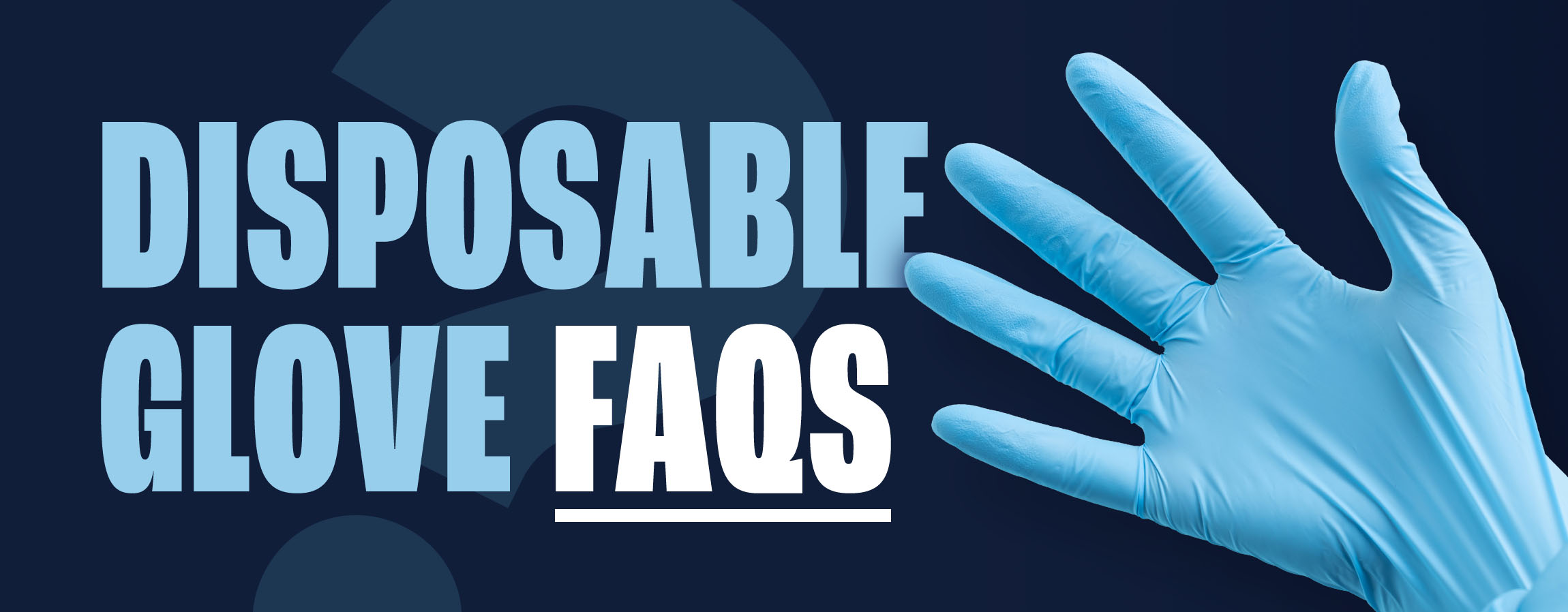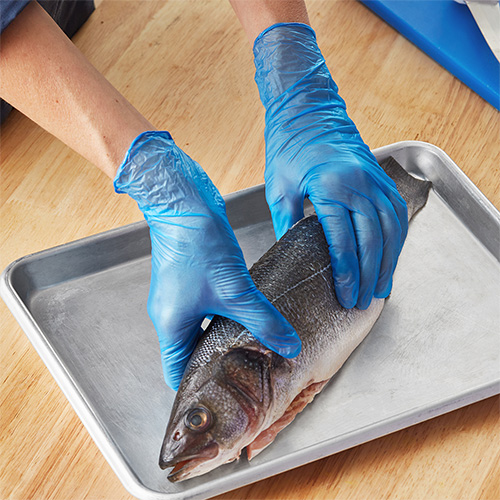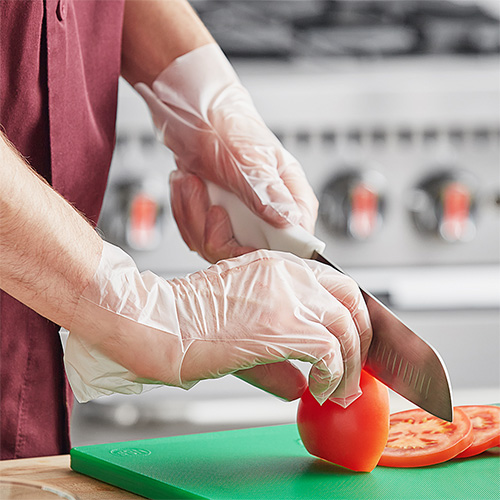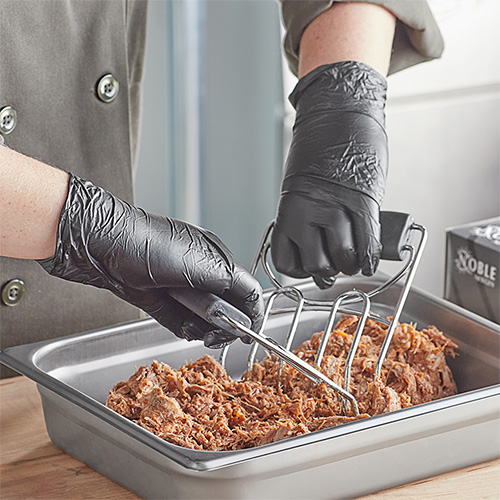
Disposable gloves are an essential part of foodservice operations, providing a barrier between food and hands to prevent cross-contamination. Questions and concerns often arise when it comes to choosing and using disposable gloves in the foodservice industry. We answer some of the most common questions to help you make informed decisions for your business.
Shop All Disposable GlovesDisposable Glove Basics

Learn more about the different types of disposable gloves and how to choose the right pair.
What Are Disposable Gloves Made Of?
Disposable gloves can be made from materials such as latex, vinyl, and nitrile. Each material offers different benefits and drawbacks. Latex gloves are known for their elasticity and comfort, but they can cause allergies in some individuals. Vinyl gloves are cost-effective and offer good resistance to punctures, but they may not provide the same level of dexterity as latex or nitrile gloves. Nitrile gloves are highly resistant to chemicals, punctures, and tears, making them ideal for food-handling tasks.
How Do I Choose the Right Size of Disposable Gloves?
Choosing the right size of disposable gloves is crucial for comfort and functionality. Gloves that are too tight can restrict movement and cause discomfort, while gloves that are too loose may not provide adequate protection. To determine the correct size, measure the circumference of your dominant hand just below the knuckles. Compare the measurement to the manufacturer's sizing chart to find the appropriate glove size. It's important to note that glove sizes may vary between manufacturers, so always refer to the specific sizing chart provided by the glove manufacturer.
Can I Reuse Disposable Gloves?
No, disposable gloves are designed for single use only. Reusing gloves can compromise food safety and increase the risk of cross-contamination. Once gloves have been used, they should be promptly discarded and replaced with a new pair. It's important to train your staff on proper glove usage and emphasize the importance of changing gloves regularly, especially when switching between different tasks or handling different types of food.
Are All Disposable Gloves Food-Safe?
No, not all disposable gloves are suitable for food handling. When purchasing gloves for foodservice applications, look for gloves that are explicitly labeled as food-safe or food-grade. These gloves have been tested and certified to meet the necessary standards for food handling. Additionally, gloves that comply with FDA regulations for food contact should be used to ensure the safety of your customers and compliance with food safety regulations.
How to Use Disposable Gloves the Right Way

Single-use gloves are an essential part of any successful food safety program, but only if they're used the right way. Learn more about how to wear disposable gloves and when to change them below.
When Are Food Handlers Required to Wear Gloves?
Between the FDA Food Code and the requirements of local health departments, it can be confusing to understand when exactly disposable gloves must be worn. We'll break down the common recommendations for wearing disposable gloves below:
- Ready-to-Eat Foods - The FDA prohibits bare-hand contact with ready-to-eat (RTE) foods. You can avoid bare-hand contact by handling these foods with a utensil or piece of wax paper, but using disposable gloves is one of the most effective and convenient options.
- Special Processes - Special processes are methods of food preparation that require a variance to be performed safely. The FDA recommends that food handlers wear gloves while performing tasks associated with the following special processes: processing beef jerky, curing and smoking meats, fermenting, making fresh juice, and handling sushi.
- Hand and Finger Wounds - If a food handler has a cut on their hands, the wound must be covered with an impermeable bandage and a disposable glove must be worn over top.
- Raw Meat, Poultry, and Seafood - There is no requirement to wear gloves while handling raw meat, poultry, and seafood that will be cooked to a minimum temperature, but it's highly recommended. These types of foods can contain harmful pathogens like Salmonella or E. coli, which can cause foodborne illnesses if not handled properly.
Should I Wear Disposable Gloves When Handling Ready-to-Eat Foods?
Yes, disposable gloves should be worn when handling ready-to-eat foods to prevent direct contact with bare hands, which can introduce contaminants. Ready-to-eat foods, such as salads, sandwiches, and fruit, are not cooked or reheated before consumption, making them more susceptible to contamination. By wearing gloves, you create a barrier between the food and your hands, reducing the risk of cross-contamination.
When Are Food Handlers Require to Change Gloves?

When it comes to food safety, one of the most important practices for food handlers is changing gloves regularly. According to the FDA's Food Code, gloves should be changed in the following situations: before starting a new task, after handling raw meat or poultry, after touching the face or body, after handling soiled utensils or equipment, and after any other activity that may contaminate the gloves. These guidelines ensure that potential cross-contamination is minimized and that food is handled safely. By following these rules, food handlers can help maintain a high standard of personal hygiene in the kitchen.
Which Food Item Can Be Handled with Bare Hands?
In general, food items that will be cooked or added to a dish that will be cooked to a required minimum temperature can be handled with bare hands. However, hands must be washed properly before handling any food.
How Long Can a Food Worker Wear Gloves?
According to ServSafe, a leading authority in food safety, there are guidelines for how long a food worker can wear disposable gloves. It is recommended that gloves be changed and replaced every four hours, or immediately after they become contaminated or torn. This is to ensure that the gloves maintain their integrity and continue to provide a barrier between the food worker's hands and the food they are handling. By following these guidelines, businesses can maintain a high level of hygiene and prevent the spread of bacteria and contaminants.
Handwashing and Disposable Gloves
Handwashing and wearing single-use gloves go hand in hand. When performed properly, both can help to prevent cross-contamination of foods.
Should Food Handlers Wash Hands before Putting On Gloves?
Yes, food handlers should wash and dry their hands before putting on a new pair of single-use gloves.
Are Gloves a Good Substitute for Handwashing?
No, disposable gloves should not be used as a substitute for proper handwashing. Unwashed hands can still spread germs to the outside of gloves when you put them on. Make sure to follow handwashing protocols in addition to wearing single-use gloves.
Should Food Handlers Wash Hands with Gloves On?
No, disposable gloves must be removed before washing hands.
Wearing disposable gloves in the foodservice industry is crucial for maintaining proper hygiene and preventing cross-contamination. Single-use gloves provide a protective barrier between the hands and food, reducing the risk of foodborne illnesses. They also help to comply with food safety regulations and maintain a positive reputation for your establishment. With a variety of glove materials and sizes available, it's easy to find the right fit for your specific needs. So, make sure to prioritize the use of disposable gloves in your foodservice operations to ensure the safety and satisfaction of your customers.





